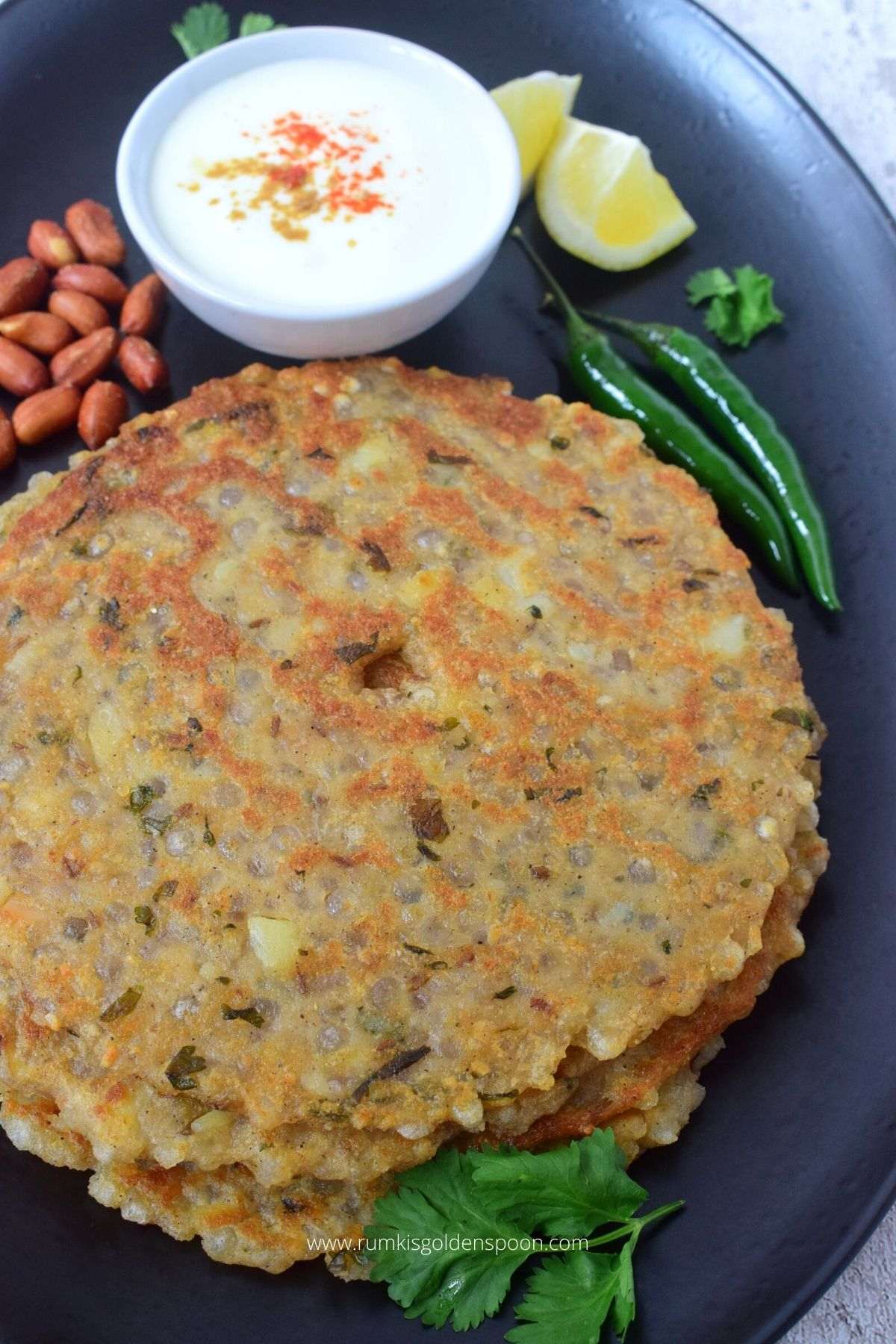Sabudana thalipeeth recipe is basically crisp and soft pancakes prepared with tapioca pearls, mashed potatoes, ground peanuts and some specific spices. It is a very delectable, healthy and comforting Maharashtrian snacks recipe which is equally popular all over India. It is a regularly prepared fasting food recipe which is consumed during vrat/upvaas of Navratri and shivratri. It is mostly served as breakfast or evening snack and even afternoon teatime snack with some curd or green chutney and tomato ketchup as side.
Sabudana thalipeeth recipe is known by different names in different regions of India. It is also referred as sabudana roti or sago roti. Other than this, it is also referred as upvasche thalipeeth and farali thalipeeth recipe. Though it is very popular but still many of us are not much aware of thalipeeth.
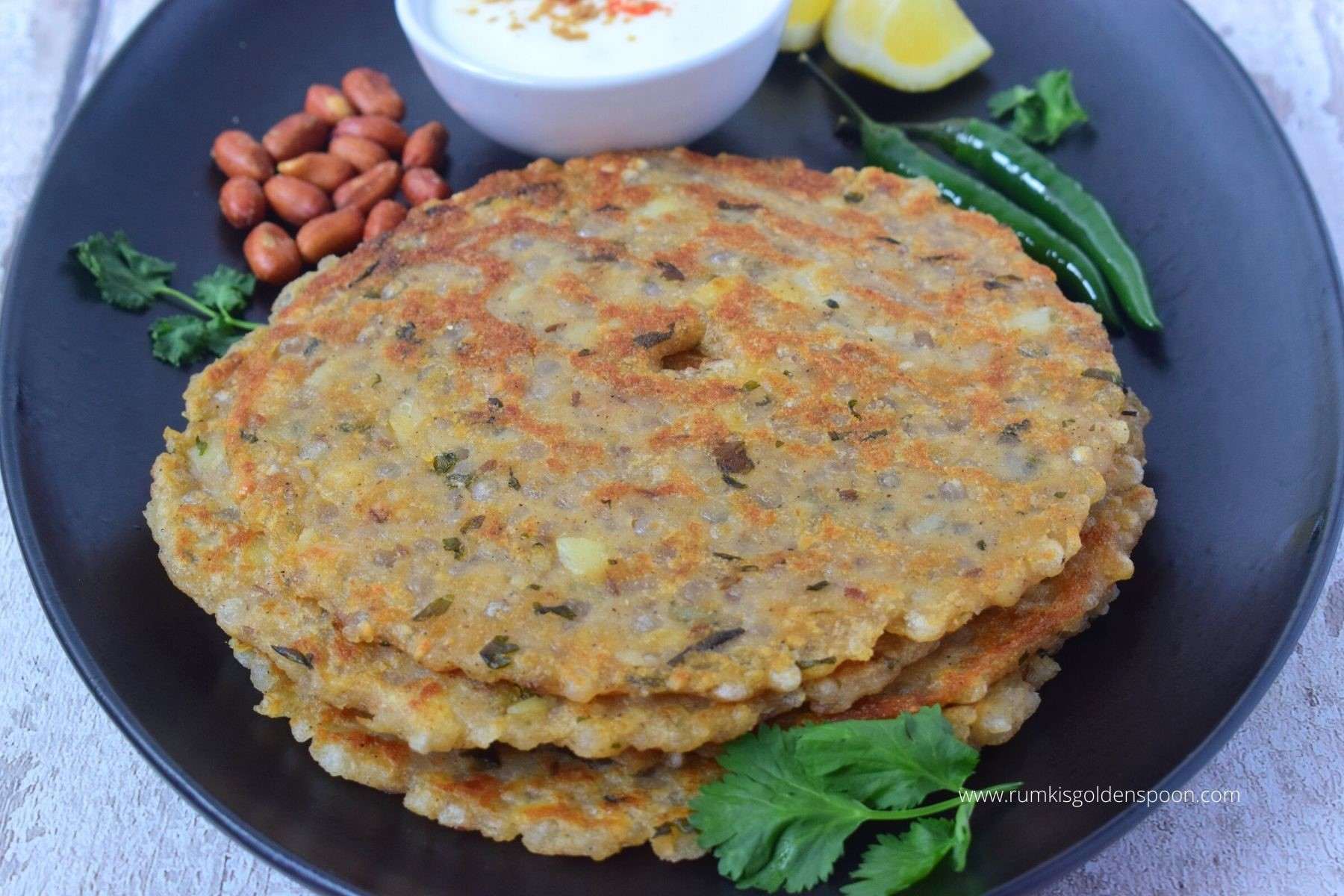
Table of Contents
About the recipe
Health Benefits of Sabudana
Tips and Suggestions
Frequently Asked Questions
How to make Sabudana Thalipeeth (step wise photos)
Recipe Card
What is thalipeeth?
Thalipeeth is one of the most popular dishes in Maharashtra. It is basically a savoury multigrain pancake prepared with ‘Bhajanee’, which is a mixture of flour prepared by roasting different varieties of grains and lentils like wheat, rice, bajra (pearl millet), jowar (sorghum), chana dal (split chickpeas lentils) and urad dal (split black lentils). First thalipeeth dough is prepared and then the dough balls are directly pressed on the flat pan. It is cooked using ghee, oil or butter till both the sides become crisp and golden in colour. Thalipeeth recipe is mostly served hot with pickle, curd or chutney. Sabudana thalipeeth is a popular farali version aka fasting food recipe of the dish.
Though sabudana recipes are quite popular during fasting and vrats, but many people of the country are still not aware of it. Before discussing further about the recipe, let me explain about sabudana and its usage in culinary.
What is Sabudana?
Sabudana is a starch extracted from tapioca roots which is commercially produced in the form of pearls in different sizes. It is gluten free and used to prepare myriad sweet and savoury dishes like sweet pudding, porridge, falooda, pancakes, soup, savoury cakes, pilaf, beverages, papad etc.
It is low in nutrient, vitamins, minerals and protein but very high in carbohydrate. So, it is always cooked with other nutritious ingredients to increase the food value. High carbohydrate content in sabudana makes you feel full for longer and works as an instant energy booster. So, it is consumed during fasting. In fact, sabudana is one of the great options for summer diet because it helps to cool down our body.
Sabudana is very popular in Indian culinary and known by different names in different parts of India. In Hindi and northern parts of India, especially in Maharashtra and Gujrat, it is popular as sabudana. In south India, like in Tamil it is known as javvarisi, in Kannada it is known as sabakki, in Telugu it is known as sagubiyyam. In other parts of India, it is mostly popular as sago or tapioca pearls.
In many countries other than India, sabudana is consumed as a regular staple in their regular diet. But before cooking sabudana, it needs to be soaked in water for few hours to let it get rehydrated.
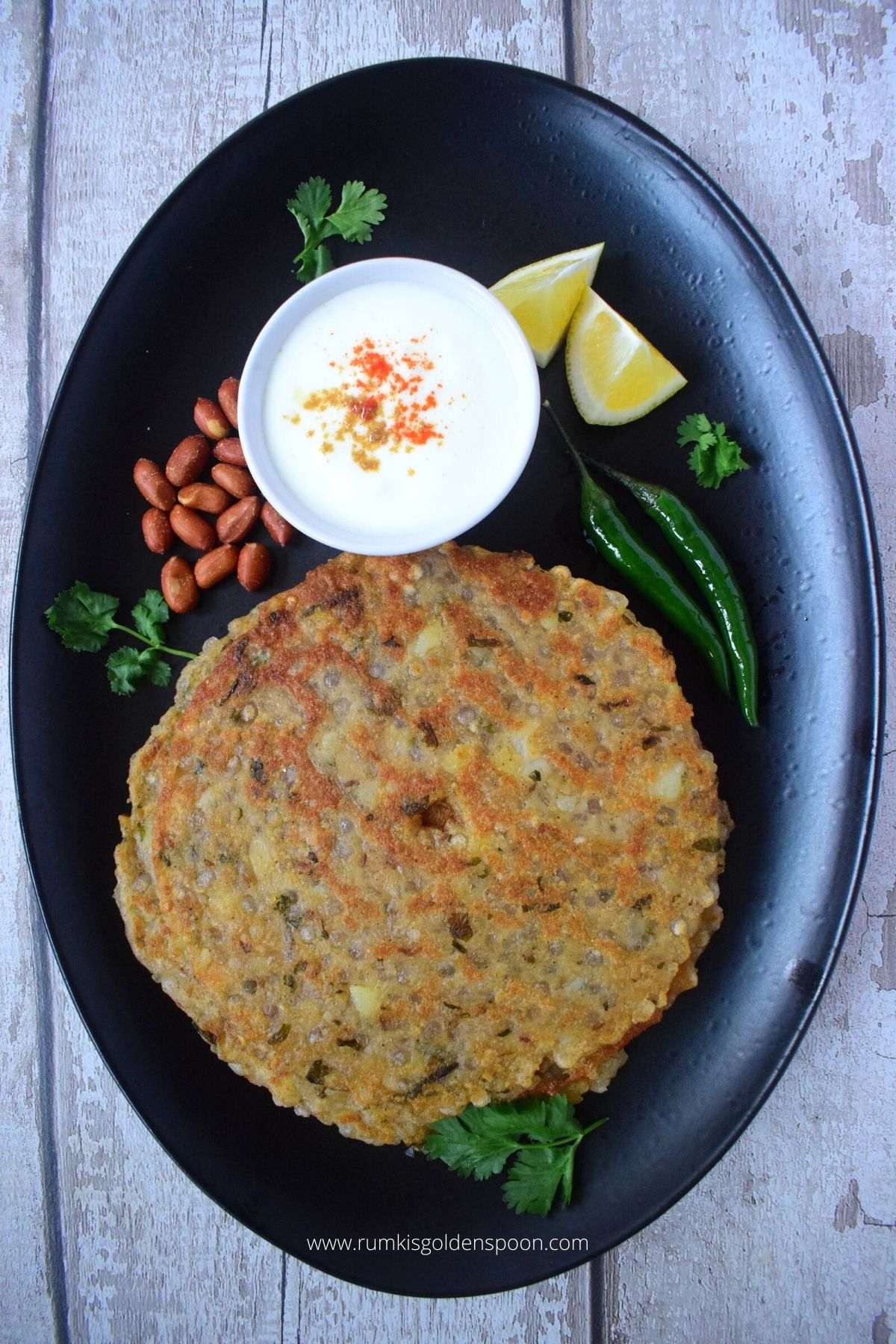
Types of Sabudana
Generally, sabudana comes in three different sizes – small, medium and large. I have used the medium sized sabudana for the sabudana thalipeeth recipe which is easily available in stores. According to me, this variety works great for the recipe.
Sabudana recipe
Sabudana aka tapioca pearl is one of the most versatile seeds which can be used to prepare different ranges of Indian recipes. It is frequently used to prepare both sweet and savoury dishes.
In sweet dishes, sabudana is mostly used to prepare porridge and pudding or kheer.
For savoury dishes, it is used to prepare main course like sabudana khichdi, sabudana vada, sabudana tikki, sabudana thalipeeth and many more. It is even used to prepare dosa, papad etc. But primarily, sabudana is used for vrat ka khana in Indian culinary.
Vrat ka khana
In Hindu religion, there are few rules and regulations for food during vrats and upvaas. Few people do nirjala upavas where they don’t even sip water before completing puja. Few people only consume fruits, few only take liquids like tea, milk, fruit juice whereas few others take a single meal on a day. People follow the rules according to their own rituals.
But there are few things which are strictly prohibited during vrats aka fasting like onion, garlic, lentils, normal salt, wheat etc. But one thing which is hugely used during vrats is sago. So, it is considered as one of the best options for fasting food when whole grains are not allowed to be consumed.
When I came to northern India after marriage, I have seen tremendous usage of sabudana in preparing different varieties of dishes on regular days as well as festive days. I just got blended with the culture and started preparing different ranges of sabudana recipes in my kitchen and sabudana thalipeeth recipe is one of them.
The dough of sabudana thalipeeth is almost alike sabudana vada. But the texture of both the dishes are completely different from each other. On the other hand, this upavasache thalipeeth recipe is shallow fried. So, it is considered healthy too as compared to deep fried vada. If you like sabudana vada then you must give a try to this recipe.
Sabudana thalipeeth recipe aka sabudana roti is a very simple and easy recipe and the difficulty level of preparing this recipe is low. It requires basic ingredients which are easily available in Indian kitchen pantry. It can also be served as vegan snacks in small parties or get togethers other than the fasting days.
This sabudana thalipeeth recipe has been prepared for vrat. So, I have used sendha namak aka rock salt and singhare ka atta for the recipe instead of normal salt and atta. I have also used ginger, cumin seeds, black pepper powder and coriander leaves in this farali thalipeeth recipe. But for many people, few of these items are forbidden during vrats. So, you can omit those ingredients from the recipe.
Sabudana thalipeeth with step by step photos and instructions have been provided in the ‘Instructions’ section of the recipe. I have included all the tips and tricks to make the recipe easier for you. If you follow the steps precisely then you will get perfect sabudana roti on your very first attempt. But before directly jumping into the recipe, let me share few interesting facts about the recipe and the key ingredient of the recipe ‘Sabudana’.
Sabudana benefits
- For the high carb content, it works as an instant energy booster.
- It could be a healthy option for weight gain.
- It is good for our digestive system and helps to resolve health issues like bloating, constipation etc.
- It helps to control the blood pressure level of our body.
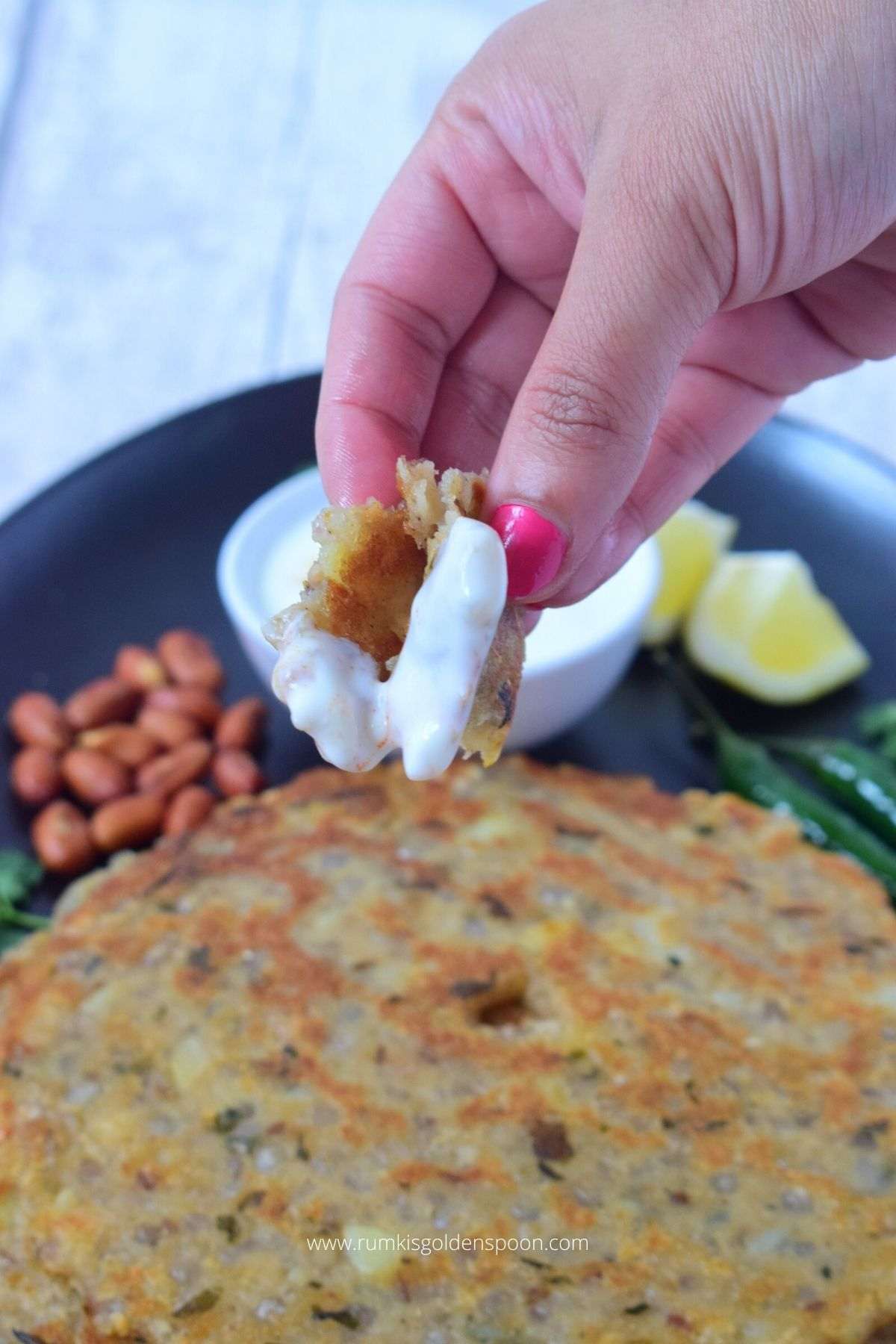
Tips and tricks to prepare perfect sabudana thalipeeth
- Soak the sabudana in enough water. If all the sabudanas don’t get soaked properly then they may splatter in oil during the time of frying.
- After soaking the sabudana, strain the excess water completely. Excess moisture results in broken sabudana thalipeeth.
- Boil the potatoes till al dente but don’t cook them mushy. After boiling the potatoes, refrigerate the peeled potatoes for 2-3 hours. This helps to give moisture free boiled potatoes.
- Grate the potatoes after refrigerating rather than mashing. It gives even and better binding to the thalipeeth dough.
- Don’t mash the sabudana during the time of mixing with potato otherwise the sabudana thalipeeth won’t get fluffy from inside.
- Add dry roasted coarsely grind peanuts into the mixture. It gives extra flavour and crunch to the sabudana roti.
- Always shape the thalipeeth either on butter paper or plastic sheet or else it may stick, and the task may become difficult. Even you can directly shape the thalipeeth on the pan where you are going to fry them.
- Though in traditional thalipeeth recipe any flour is not added, but I personally prefer to add small amount of singhare ka atta for better binding.
- Make a small hole at the centre of the shaped thalipeeth to drizzle oil during the time of frying. In this way, the oil gets distributed evenly and the thalipeeth gets fried perfectly with outer crisp.
- Always shape medium thick thalipeeth for the recipe. If it is too thick then it won’t get cooked from inside properly and if it is too thin, then it may break during the time of frying.
- Always fry the sabudana thalipeeth on medium flame. On high flame, it won’t get cooked from the centre and on low flame it may become oily and soggy.
Frequently asked Questions
Why my sabudana thalipeeth are uncooked from inside?
If you fry the sabudana thalipeeth on high flame, then it would get brown from outside quickly but would not get cooked from the inside.
Can I skip peanuts from sabudana vada due to nut allergy?
You can skip peanuts from the recipe if you are allergic. Instead of peanut, you can use almond too.
Are sabudana vada gluten free?
Sabudana thalipeeth are completely gluten free if you skip adding flour into the dough. It is a perfect high curb snack recipe.
Are sabudana vada vegan?
This sabudana thalipeeth recipe is 100% vegan.
How can I reheat sabudana thalipeeth?
The best way to reheat the sabudana thalipeeth is using oven and stove top. Preheat the oven at 180°C/ 160°C fan for 10 minutes and then heat them at the middle of the oven for 6-8 minutes.
Or else, you can heat a non-stick pan and heat each thalipeeth on medium flame for 1-2 minutes. Don’t heat it in microwave. It makes the thalipeeth chewy.
Why does my sabudana vada break?
If there is excess moisture in the sabudana thalipeeth mixture either due to over soaking of sabudana or mushy boiled potatoes, it may break during the time of frying. To instantly fix this problem, you can add one tablespoon of flour into the mixture. If you are preparing the sabudana thalipeeth for vrat then you can use kuttu ka atta aka buckwheat flour or singhade ka atta aka chestnut flour for the recipe.
How to make sabudana thalipeeth?
To prepare the sabudana thalipeeth recipe, first wash the sabudana for couple of times until the water gets clear and then soak it in water for 5-6 hours or for overnight. Then strain the sabudana to drain the excess water.
On the other hand, boil a potato till al dente, peel it and refrigerate for at least 2-3 hours. Then grate the boiled potato and keep it aside.
Dry roast peanut over medium flame for few minutes and transfer them on a plate to cool down. Take peanut into the small jar of a grinder and pulse it to coarsely ground texture.
Then in a large mixing bowl, add soaked sabudana, grated potato, coarsely grind peanuts, chopped coriander leaves, grated ginger or ginger paste, finely chopped green chillies, cumin seeds, salt, black pepper powder, sugar, lemon juice and mix all the ingredients nicely. Add small amount of singhade ka atta as much required for better binding. But don’t mash the sabudana during the time of mixing.
Take butter paper on a flat surface and add some oil. Spread the oil evenly to grease the paper. It avoids the dough to stick during the time of shaping the thalipeeth. Take large ball size thalipeeth dough and flatten it to a flat circle like paratha using hand. The thickness of the sabudana thalipeeth should be medium. Make a hole at the centre of the roti using your index finger.
Now put tawa on medium flame and allow it to become hot. Add some oil and grease the tawa. Flip the shaped thalipeeth over the tawa and remove the butter paper aka wax paper slowly. Add some oil at the centre of the thalipeeth and fry them evenly over medium flame from both the sides till crispy and golden brown in colour.
Repeat the same process with rest of the sabudana thalipeeth dough and prepare the upavasache thalipeeth recipe.
Many vrat ka khana for Navratri have already been shared in my previous posts. I hope you may like few of those recipes like
Sabudana ki khichdi
Makhana kheer
Sabudana vada
Gur makhana
..And Many more…
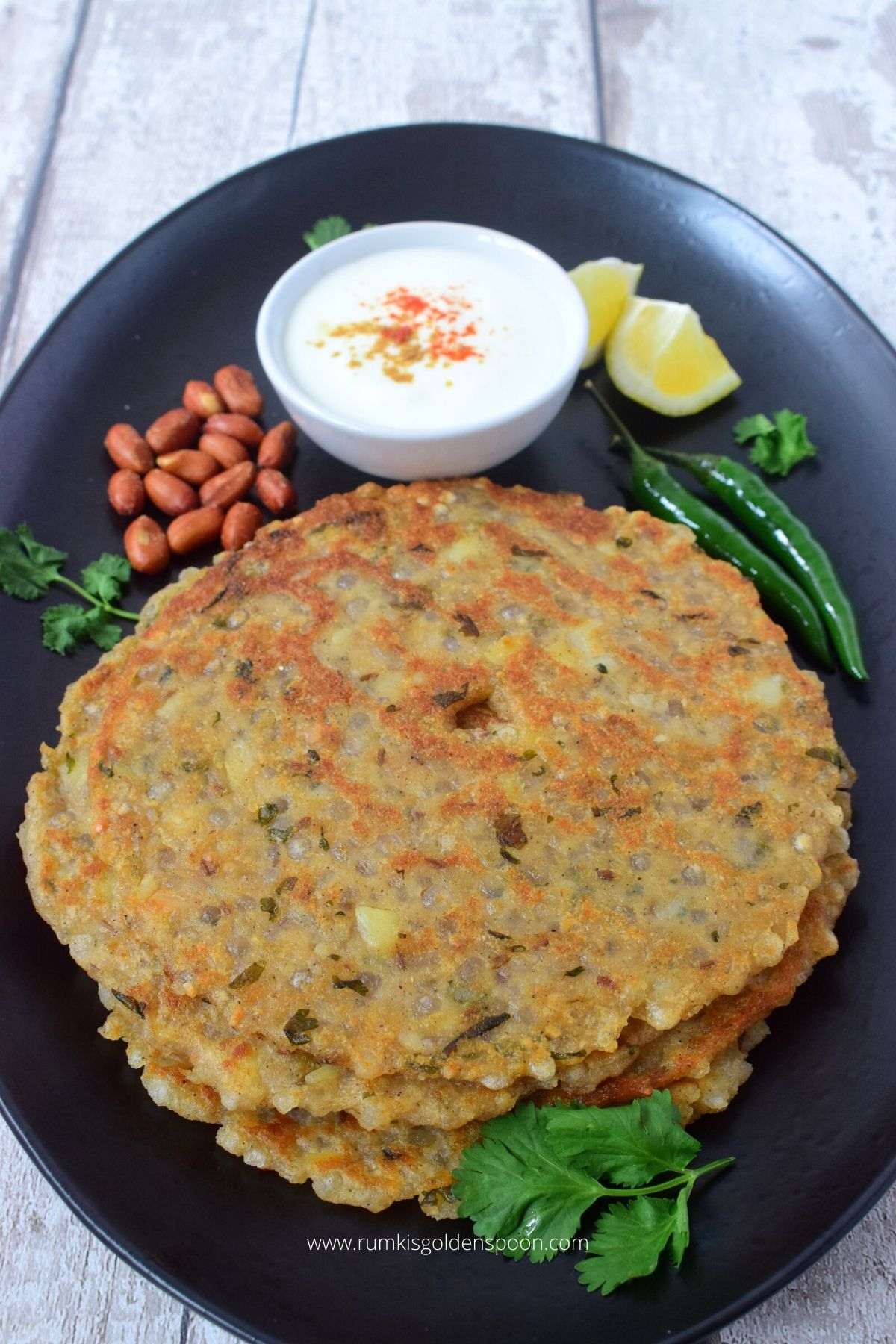
Ingredients:
1 Cup = 250 ml
- 1 cup Sabudana (Tapioca Pearl)
- 1½ cups Water, to soak the Sabudana
- 2 medium Potatoes
- ¼ cup Peanuts
- ¼ cup Singhade ka atta (Chestnut flour)
- 3-4 tablespoons Coriander leaves, chopped
- ½ tablespoon Ginger, grated or paste
- 1 tablespoon green Chilli, finely chopped
- 1 teaspoon Cumin seeds
- 1 teaspoon Black Pepper powder
- 1 teaspoon Sugar
- 1 teaspoon Salt, according to taste
- ½ Lemon or 1 tablespoon Lemon juice
- Oil to fry the Sabudana thalipeeth
Instructions:
- Wash 1 cup of sabudana properly in ample amount of water for couple of times. Rub the sabudana gently with fingers and wash out the excess powdered starch.
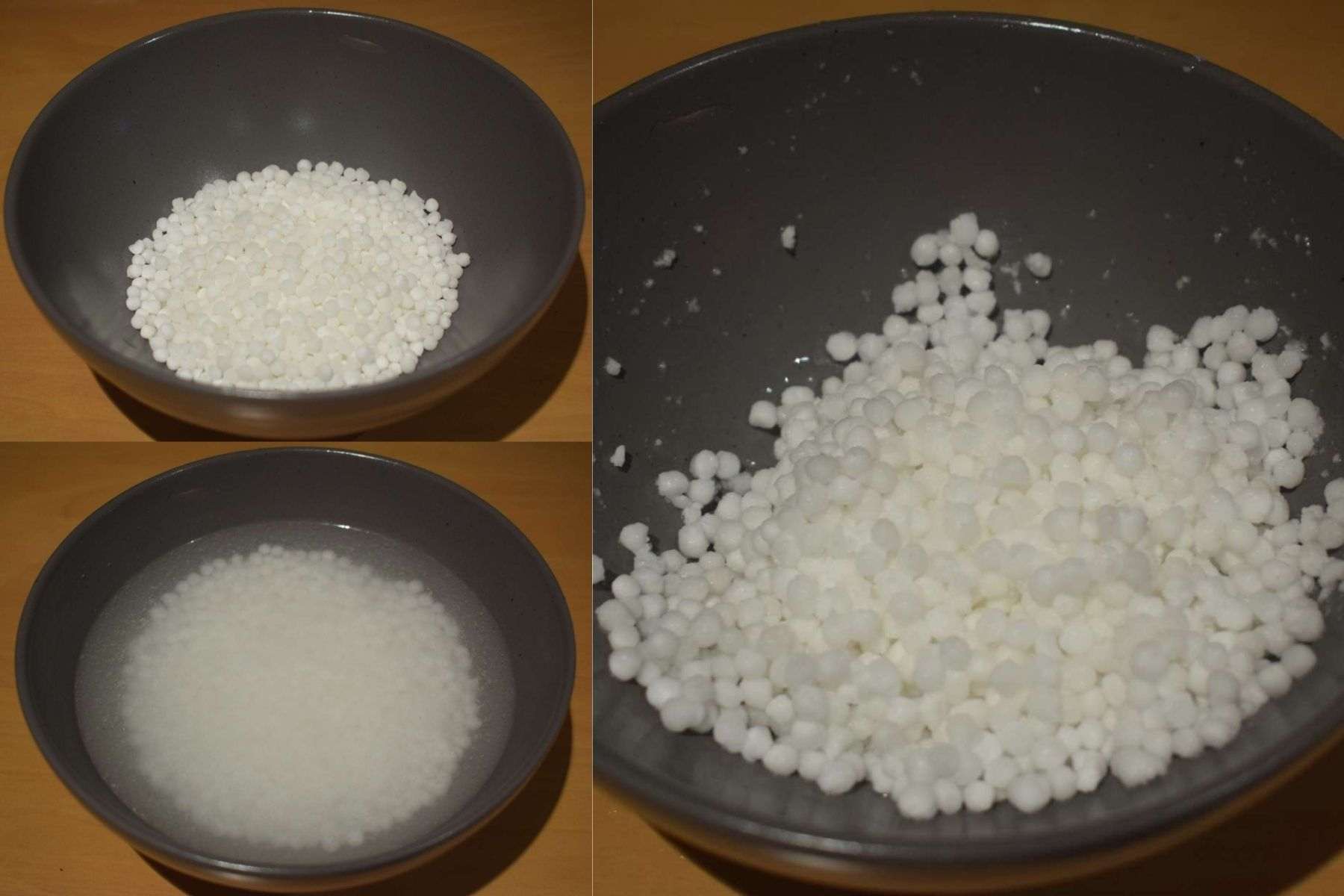
- Soak 1 cup sabudana in 1½ cups of water in a bowl for overnight or at least for 6 hours.
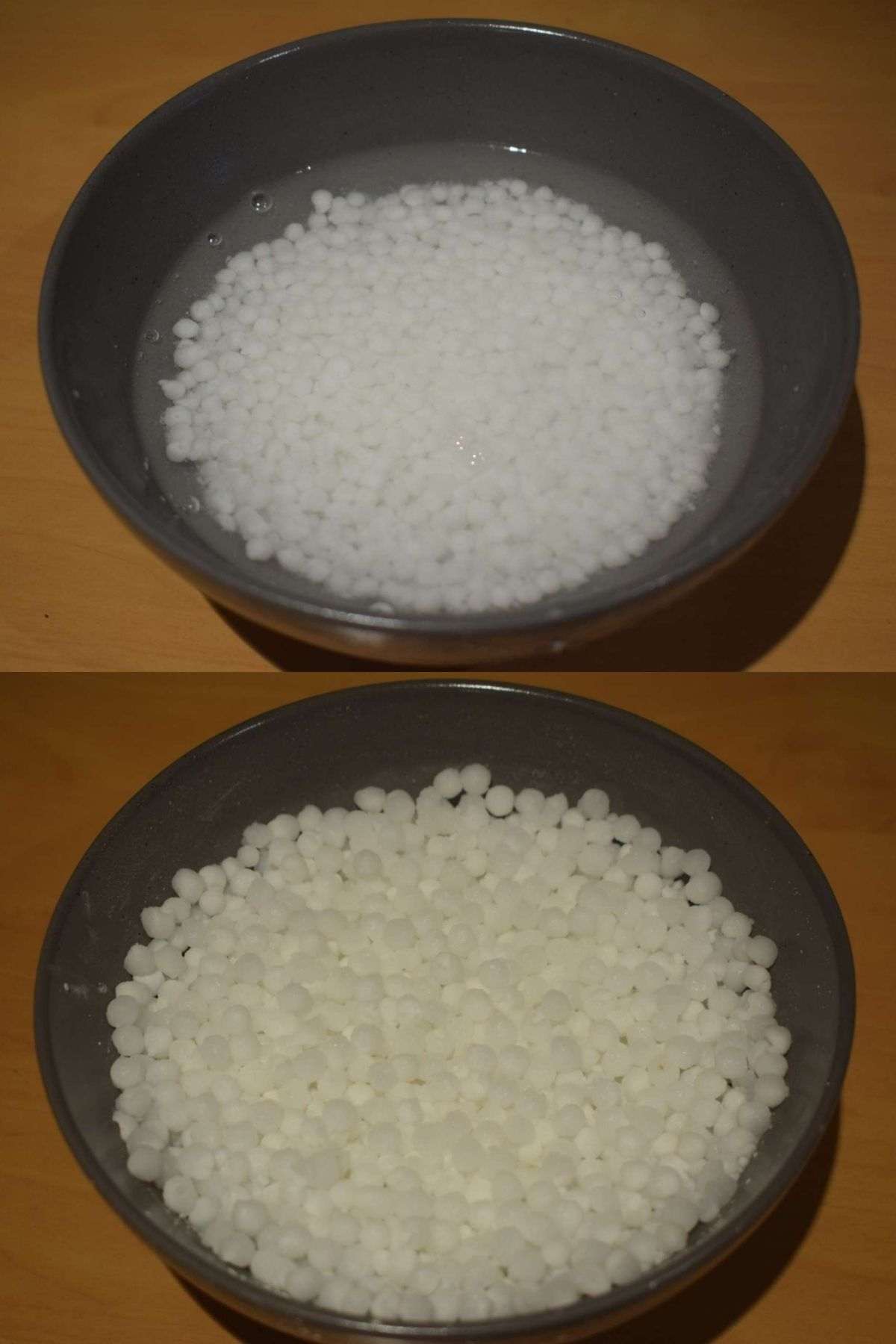
- Check the sabudana next day with finger test by mashing the pearl with your index finger and thumb. If it gets mashed, then it’s done. If not, then sprinkle some more water and soak it for another couple of hours. Drain the soaked sabudana with the help of a strainer to get rid of the excess moisture from it.
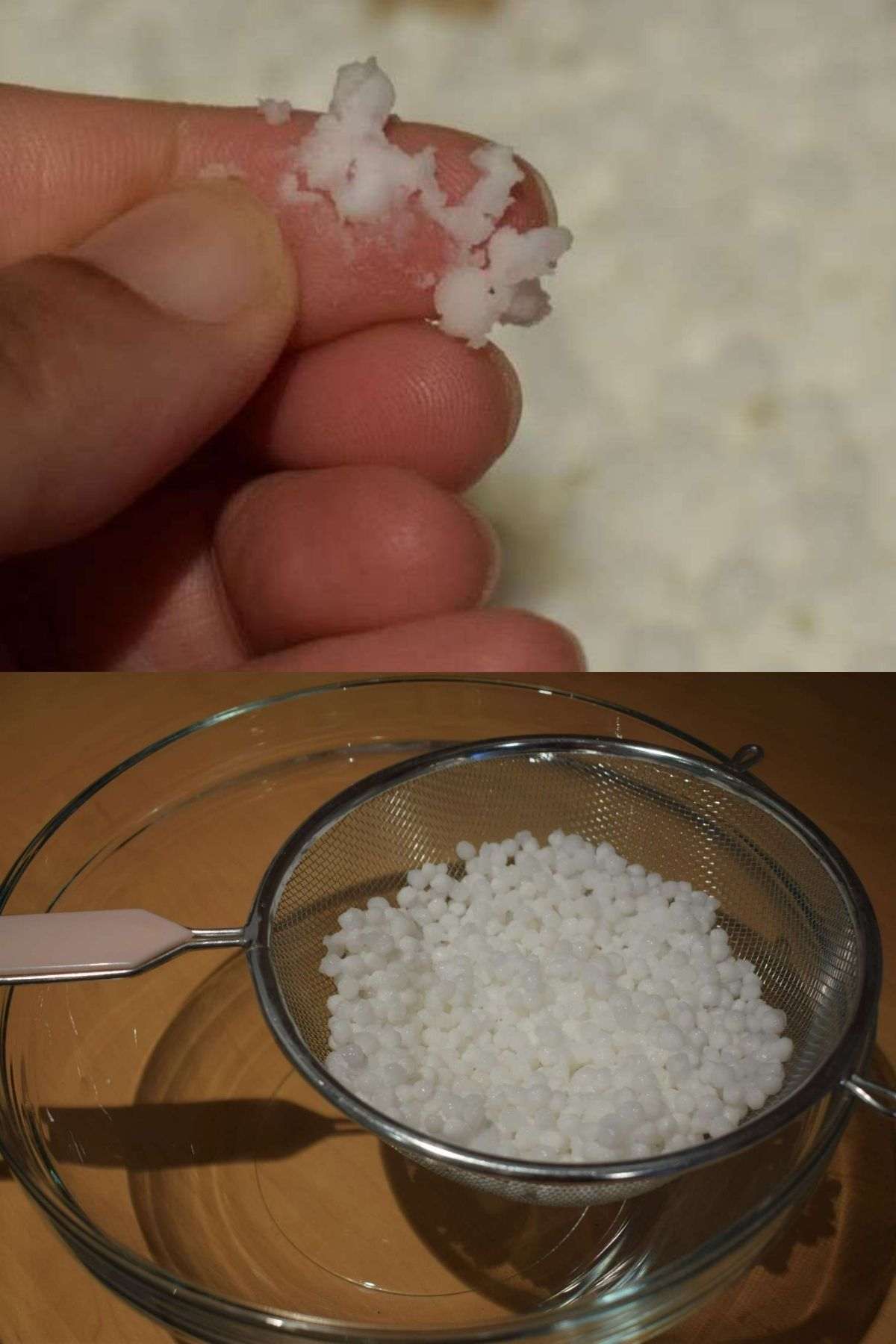
- On the other hand, put a pan on flame and add ¼ cup peanuts into it. Dry roast the peanuts over medium flame for couple of minutes and keep them aside on a plate to cool down.

- Take the roasted peanut into the jar of a grinder and pulse them to a coarsely ground powder. Keep it aside.
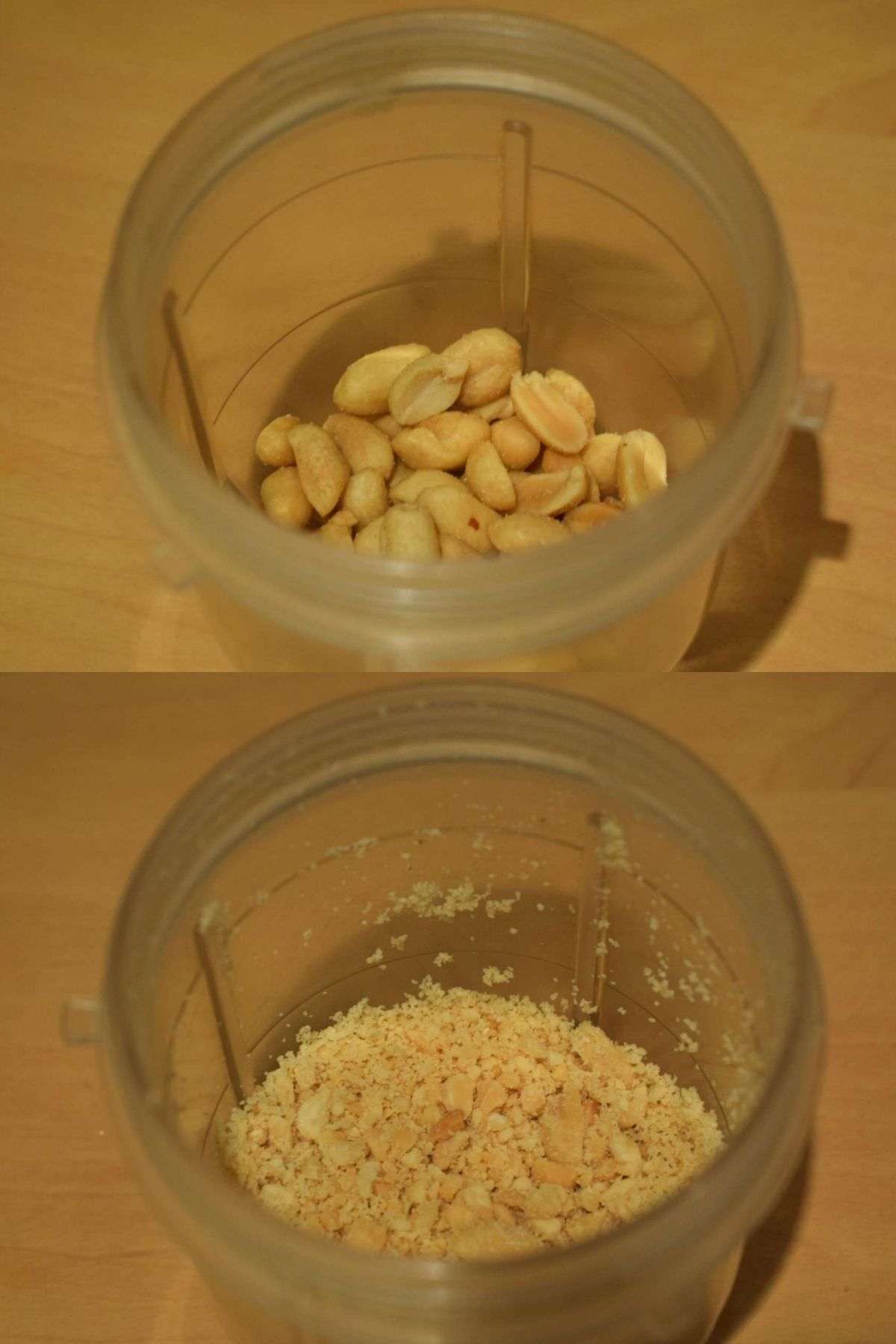
- Wash 2 potatoes and put them in the pressure cooker with enough water. Close the lid of the cooker and cook them over medium flame till 2 whistles. Switch off the flame and allow the pressure cooker to release pressure. Cook the potatoes till al dente not mushy. Let the potatoes cool down till touchable and peel the skin off.
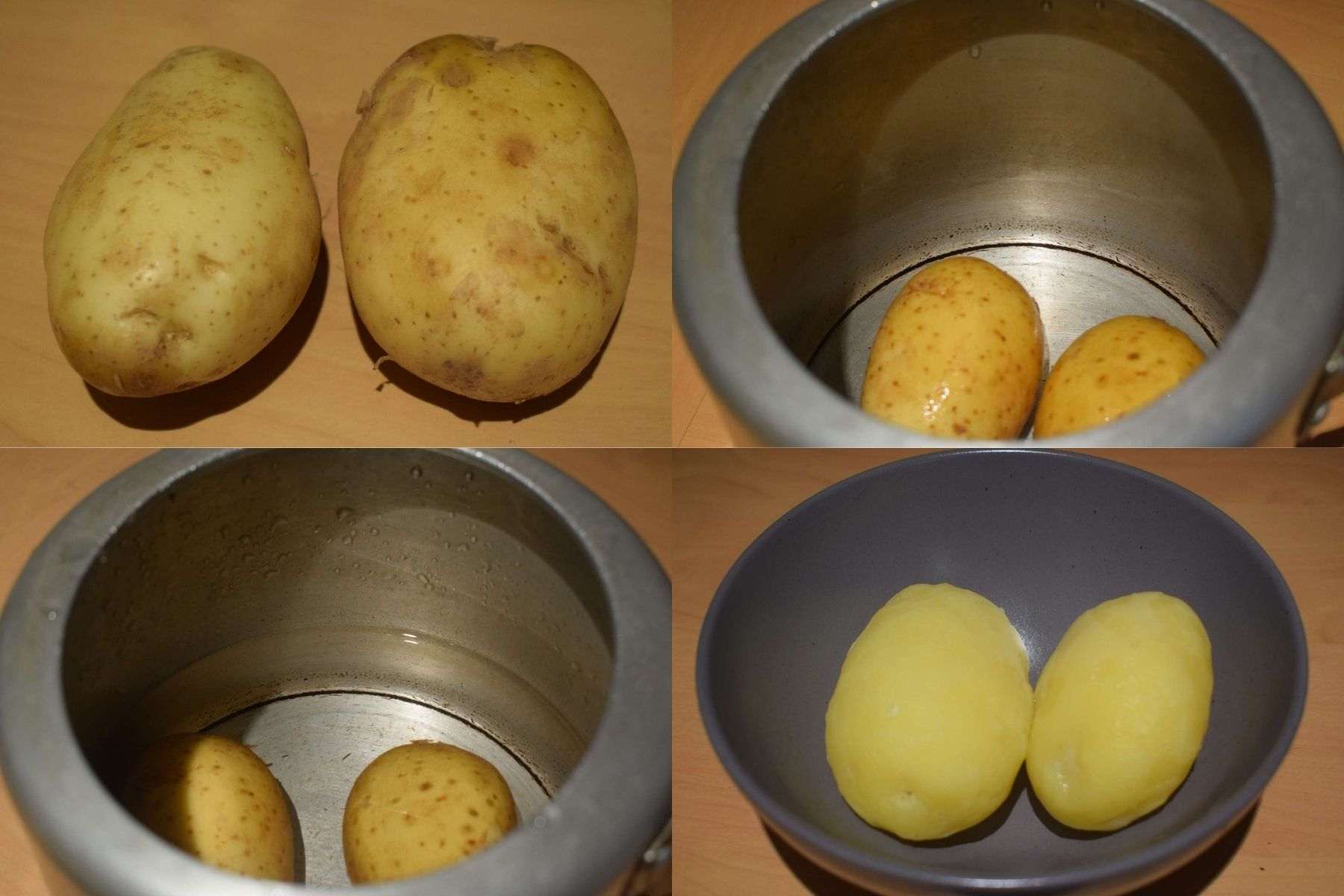
- Put the potatoes into refrigerator for 2-3 hours. Then grate the potatoes and keep it aside.

- Take a large mixing bowl and add stained sabudana (step 3) into the bowl. Add the grated potato (Step 7) and coarsely ground peanut (Step 5) into the bowl.

- Add 4 tablespoons coriander leaves, ½ tablespoon ginger paste, 1 tablespoon chopped green chillies, 1 teaspoon cumin seeds, 1 teaspoon black pepper powder, 1 tablespoon lemon juice, 1 teaspoon sugar and salt, one by one into the bowl.
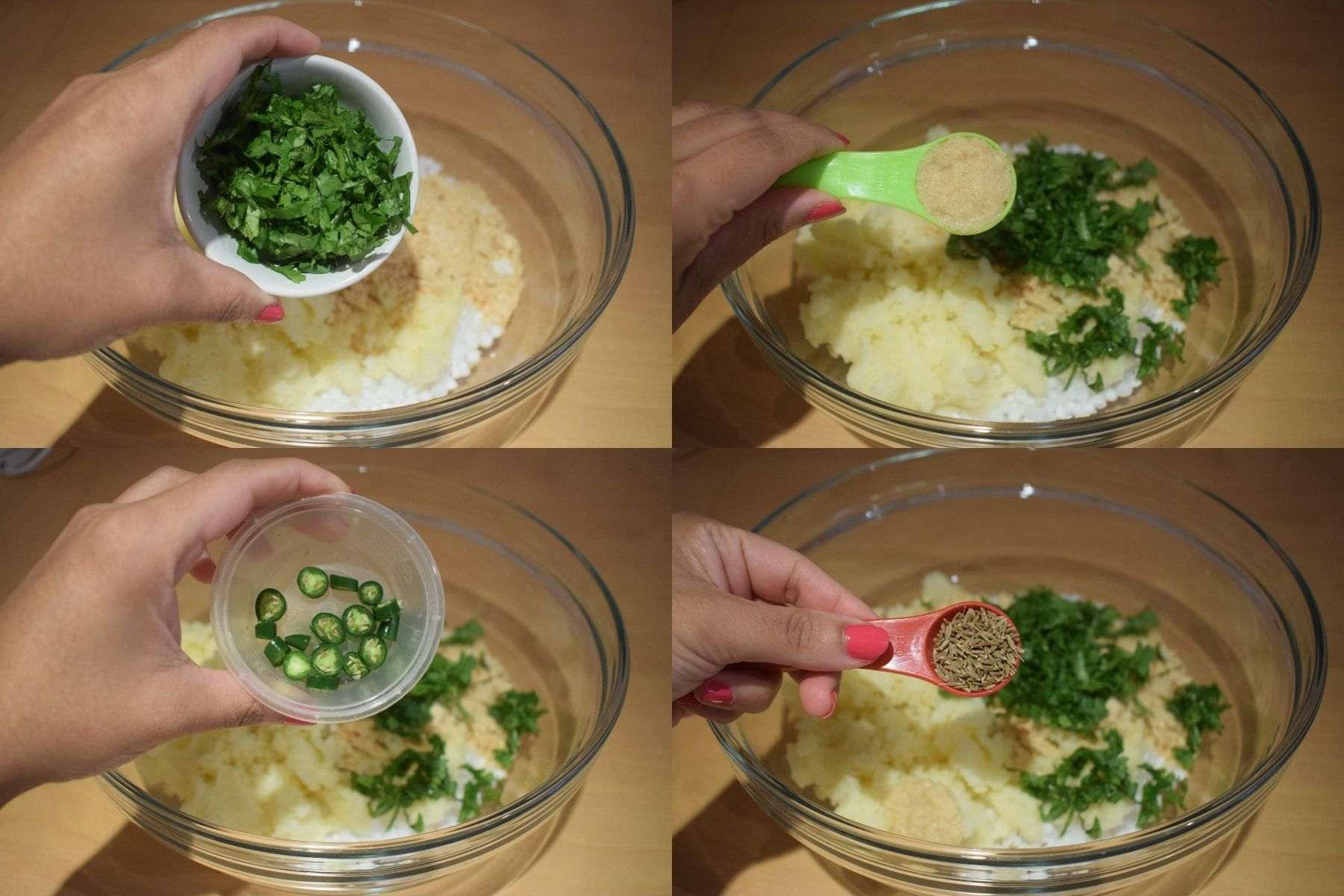
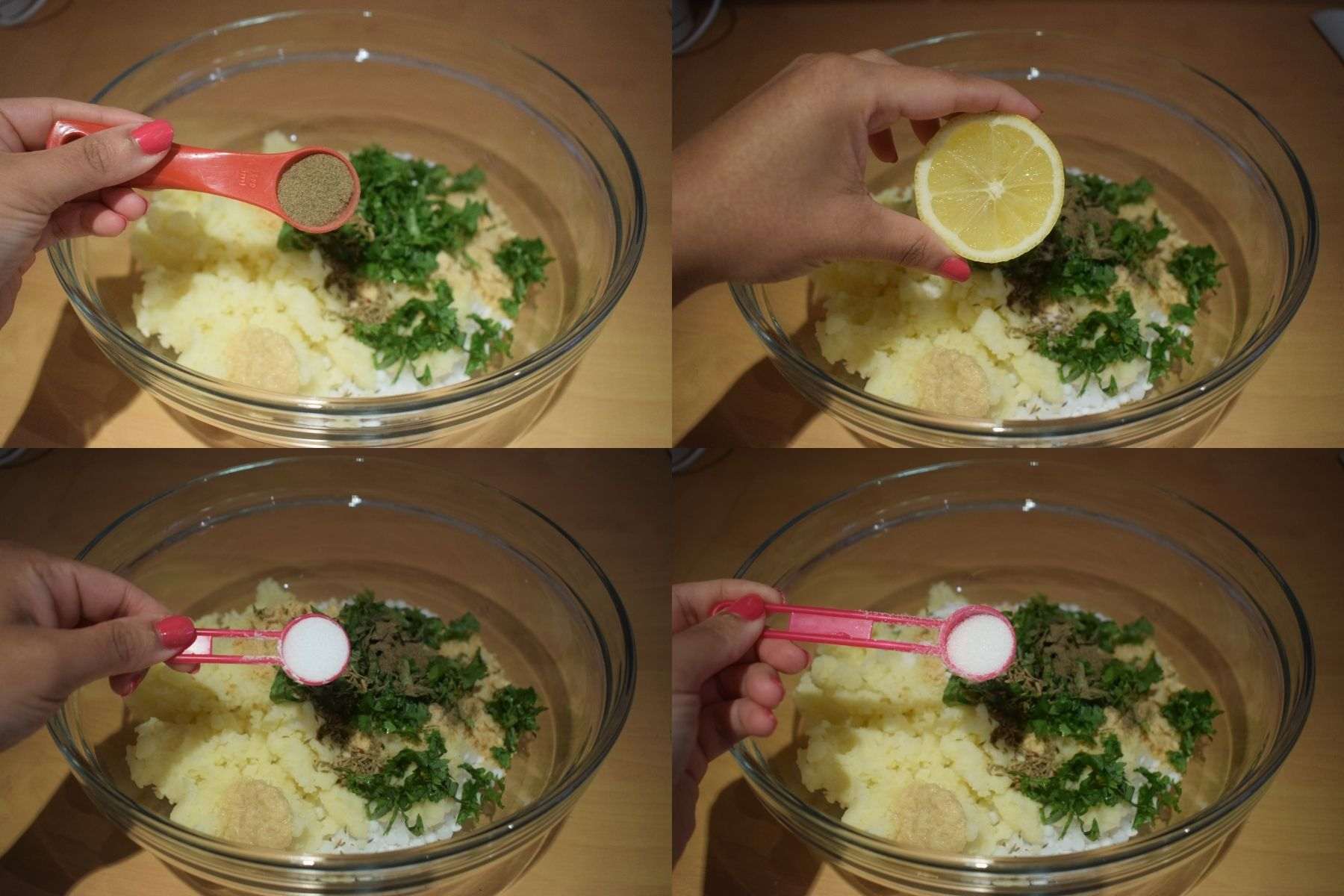
- Mix all the ingredients nicely with the help of hand but don’t mash the sago aka tapioca pearls.

- Add ¼ cup singhade ka atta aka chestnut flour into the bowl and mix it evenly and prepare the dough.
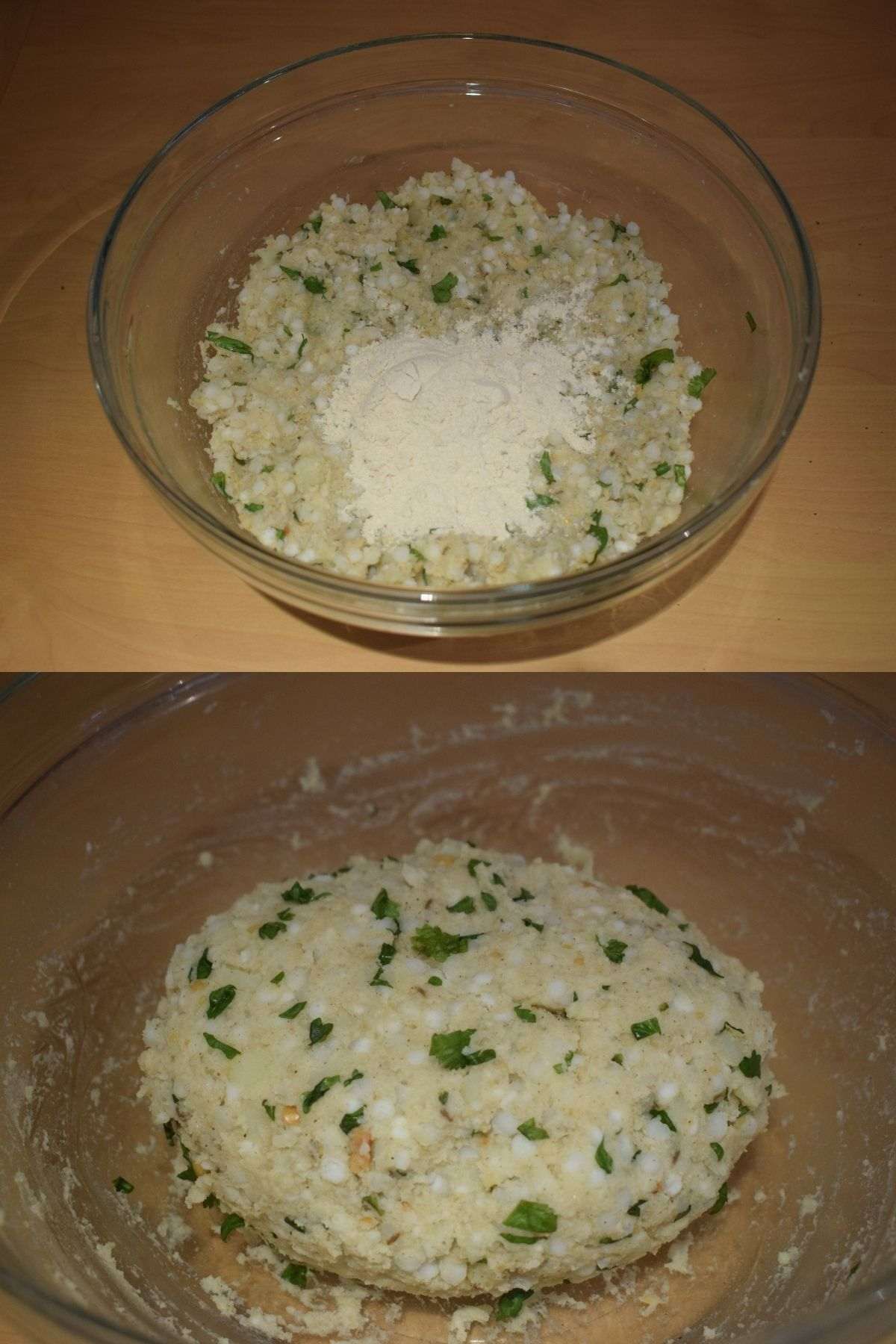
- Take a piece of butter paper aka wax paper on a flat surface and add some oil. Spread the oil evenly to grease the paper.
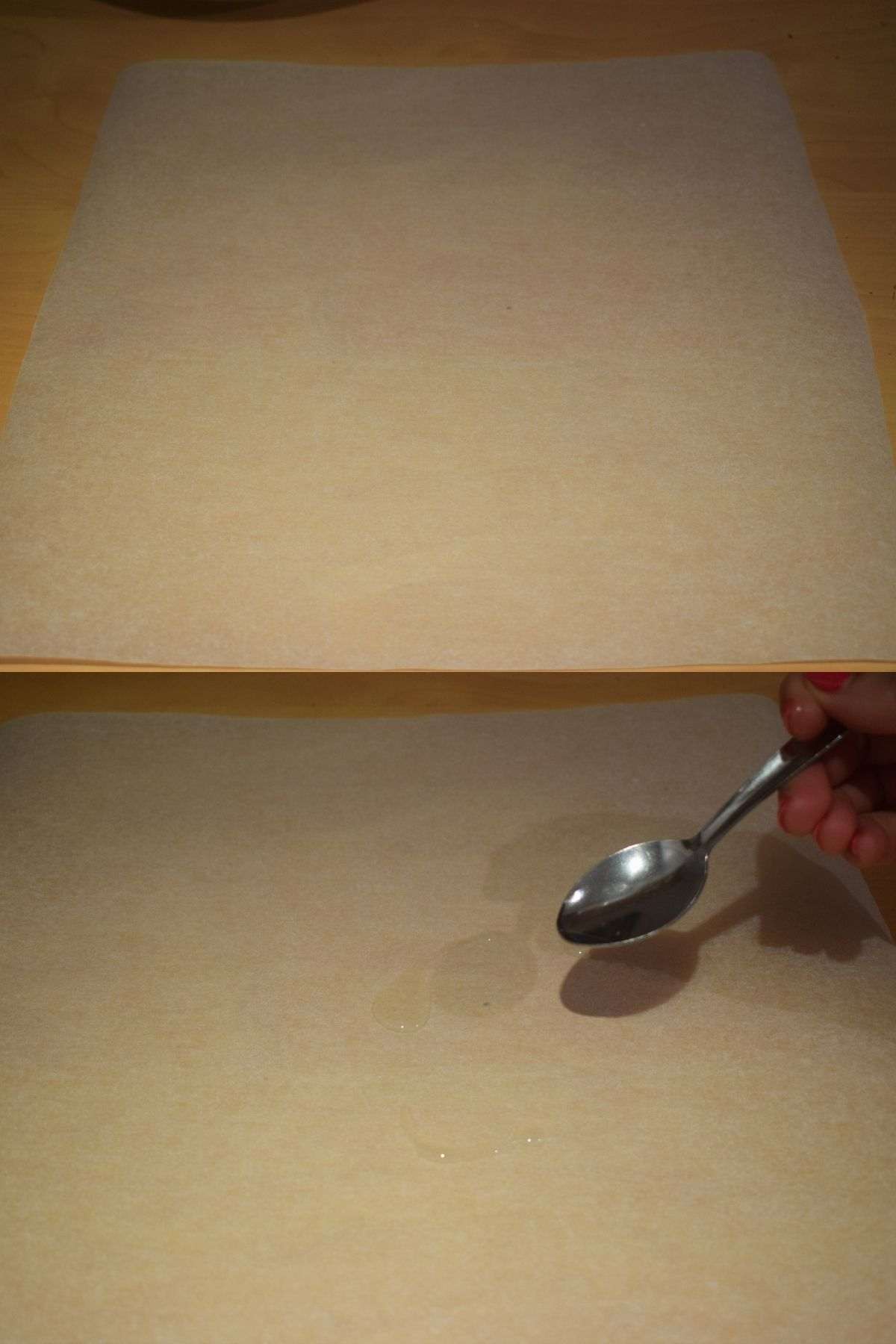
Note: It avoids the dough to stick during the time of shaping the thalipeeth. - Take large ball size thalipeeth dough and flatten it on the greased wax paper to a flat circle like paratha by pressing with hand. The thickness of the sabudana thalipeeth should be medium. Make a hole at the centre of the roti using your index finger.
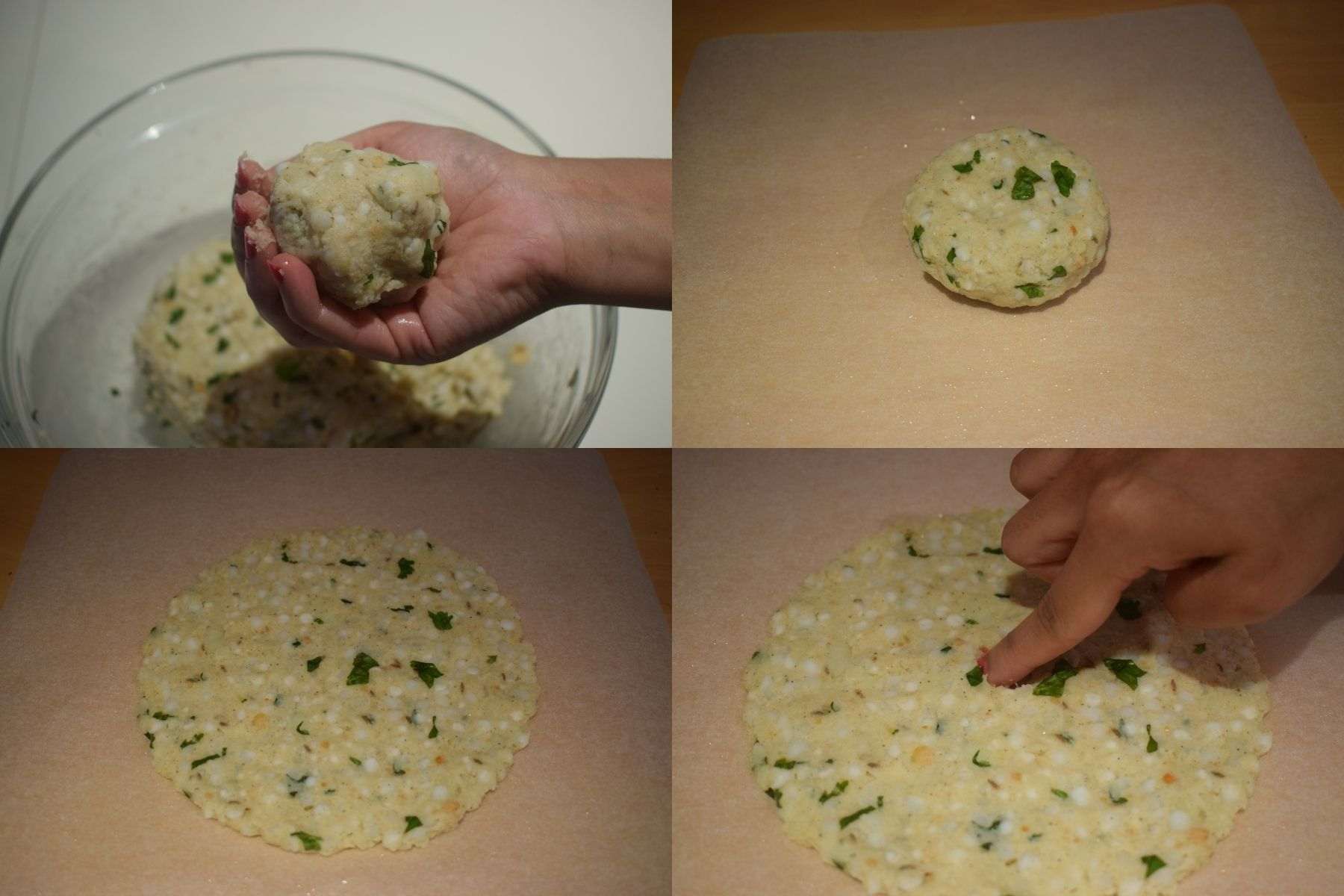
- Now put tawa on medium flame and allow it to become hot. Add some oil and grease the tawa.
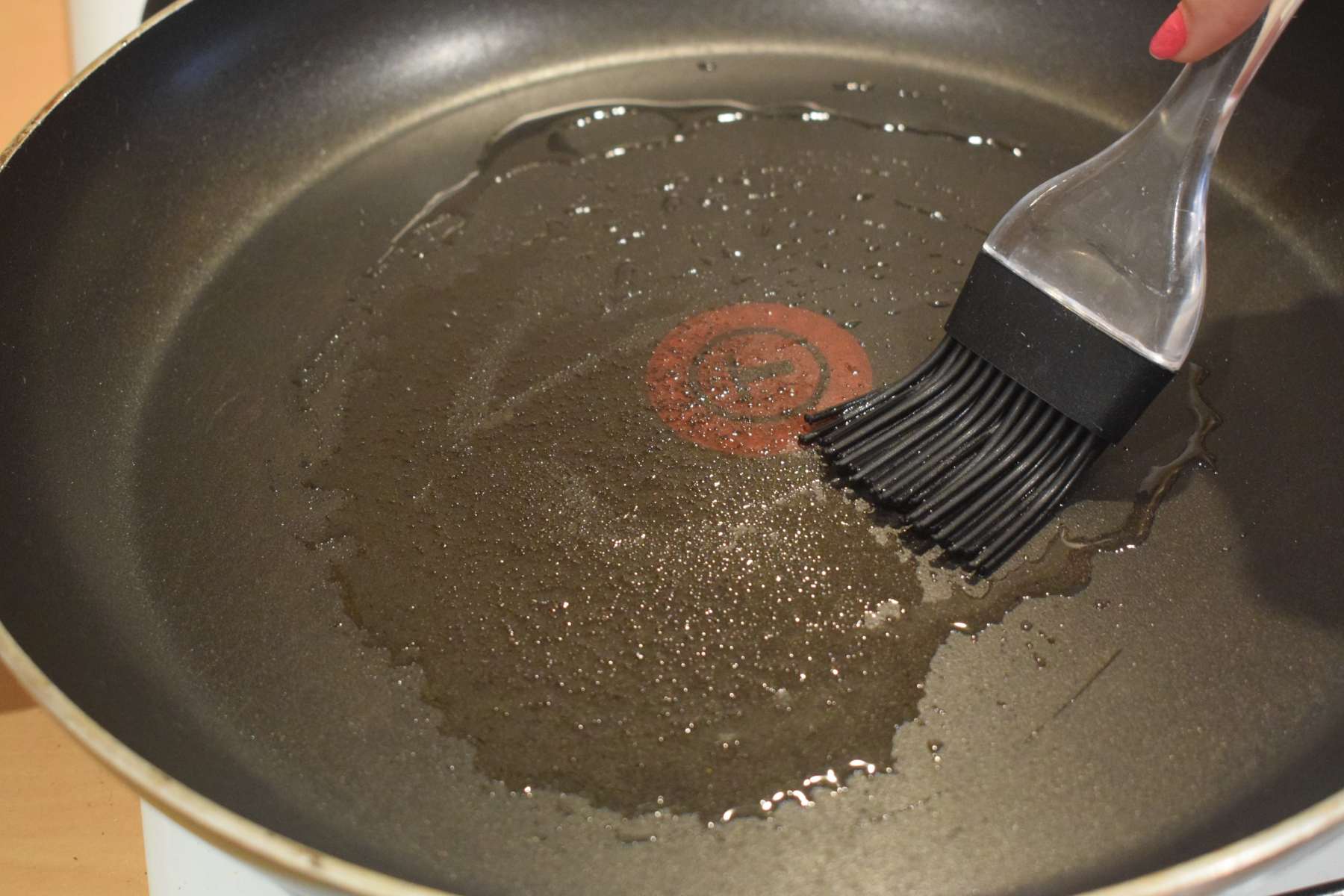
- Flip the shaped thalipeeth over the tawa and remove the butter paper aka wax paper slowly. Add some oil at the centre of the thalipeeth and fry them evenly over medium flame from both the sides till crispy and golden brown in colour.
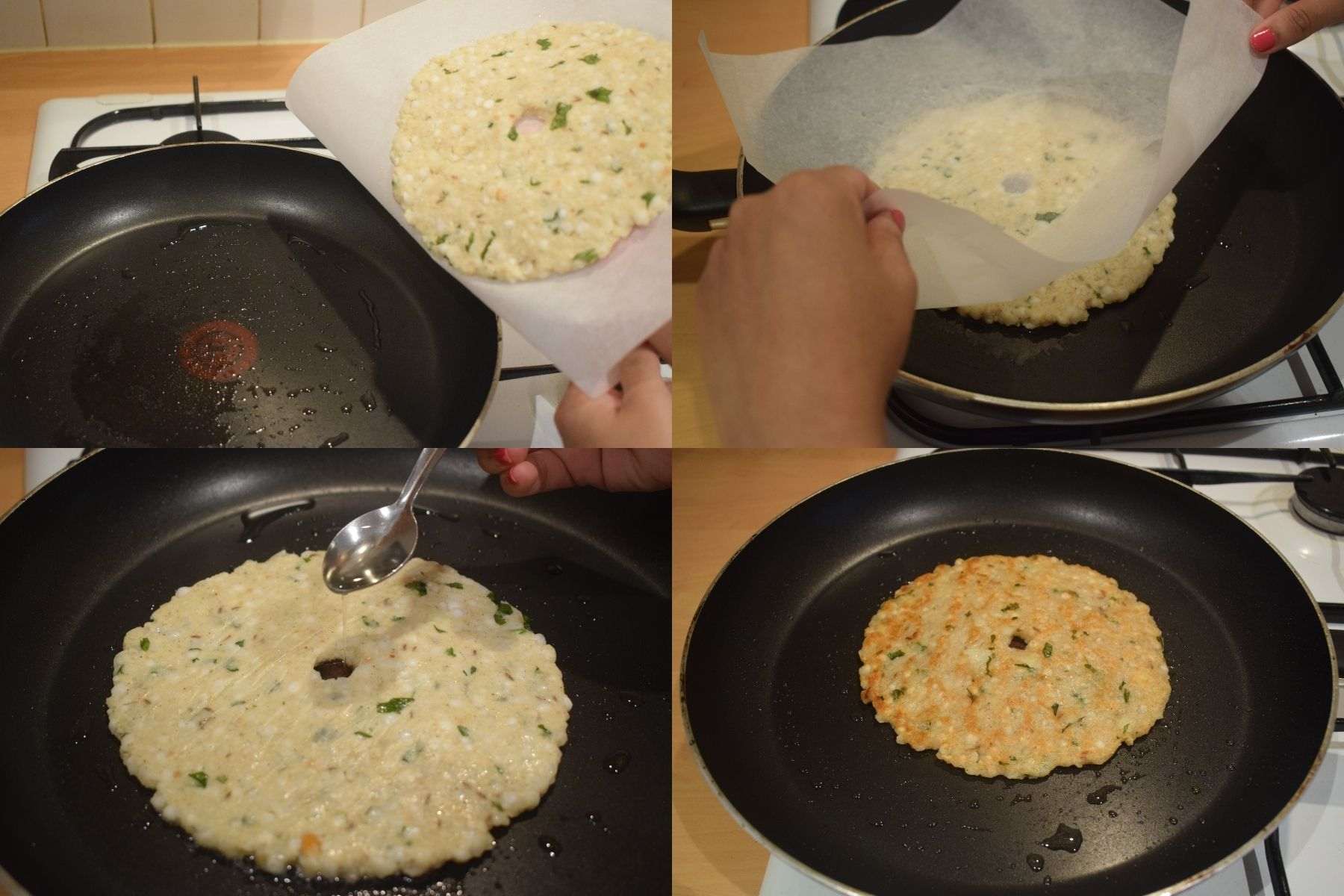
- Repeat the same process with rest of the dough and prepare the upavasache thalipeeth recipe.

- Serve hot with some yogurt or some ketchup or green chutney.
Serving Instruction
Transfer the sabudana thalipeeth on serving plate. Serve immediately to enjoy its crunch. Serve it with either spiced yogurt, green chutney or tomato ketchup and enjoy the delectable snack.
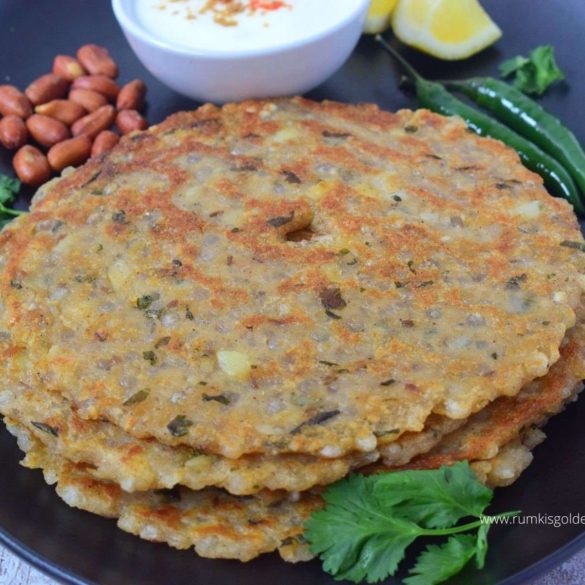
Ingredients
1 Cup = 250 ml
- 1 cup Sabudana (Tapioca Pearl)
- 1½ cups Water, to soak the Sabudana
- 2 medium Potatoes
- ¼ cup Peanuts
- ¼ cup Singhade ka atta (Chestnut flour)
- 3-4 tablespoons Coriander leaves, chopped
- ½ tablespoon Ginger, grated or paste
- 1 tablespoon green Chilli, finely chopped
- 1 teaspoon Cumin seeds
- 1 teaspoon Black Pepper powder
- 1 teaspoon Sugar
- 1 teaspoon Salt, according to taste
- ½ Lemon or 1 tablespoon Lemon juice
- Oil to fry the Sabudana thalipeeth
Instructions
- Wash 1 cup of sabudana properly in ample amount of water for couple of times. Rub the sabudana gently with fingers and wash out the excess powdered starch.
- Soak 1 cup sabudana in 1½ cups of water in a bowl for overnight or at least for 6 hours.
- Check the sabudana next day with finger test by mashing the pearl with your index finger and thumb. If it gets mashed, then it’s done. If not, then sprinkle some more water and soak it for another couple of hours. Drain the soaked sabudana with the help of a strainer to get rid of the excess moisture from it.
- On the other hand, put a pan on flame and add ¼ cup peanuts into it. Dry roast the peanuts over medium flame for couple of minutes and keep them aside on a plate to cool down.
- Take the roasted peanut into the jar of a grinder and pulse them to a coarsely ground powder. Keep it aside.
- Wash 2 potatoes and put them in the pressure cooker with enough water. Close the lid of the cooker and cook them over medium flame till 2 whistles. Switch off the flame and allow the pressure cooker to release pressure. Cook the potatoes till al dente not mushy. Let the potatoes cool down till touchable and peel the skin off.
- Put the potatoes into refrigerator for 2-3 hours. Then grate the potatoes and keep it aside.
- Take a large mixing bowl and add stained sabudana (step 3) into the bowl. Add the grated potato (Step 7) and coarsely ground peanut (Step 5) into the bowl.
- Add 4 tablespoons coriander leaves, ½ tablespoon ginger paste, 1 tablespoon chopped green chillies, 1 teaspoon cumin seeds, 1 teaspoon black pepper powder, 1 tablespoon lemon juice, 1 teaspoon sugar and salt, one by one into the bowl.
- Mix all the ingredients nicely with the help of hand but don’t mash the sago aka tapioca pearls.
- Add ¼ cup singhade ka atta aka chestnut flour into the bowl and mix it evenly and prepare the dough.
- Take a piece of butter paper aka wax paper on a flat surface and add some oil. Spread the oil evenly to grease the paper.
Note: It avoids the dough to stick during the time of shaping the thalipeeth.
- Take large ball size thalipeeth dough and flatten it on the greased wax paper to a flat circle like paratha by pressing with hand. The thickness of the sabudana thalipeeth should be medium. Make a hole at the centre of the roti using your index finger.
- Now put tawa on medium flame and allow it to become hot. Add some oil and grease the tawa.
- Flip the shaped thalipeeth over the tawa and remove the butter paper aka wax paper slowly. Add some oil at the centre of the thalipeeth and fry them evenly over medium flame from both the sides till crispy and golden brown in colour.
- Repeat the same process with rest of the dough and prepare the upavasache thalipeeth recipe.
Serve hot with some yogurt or some ketchup or green chutney.

